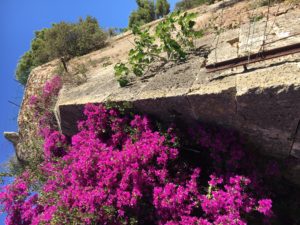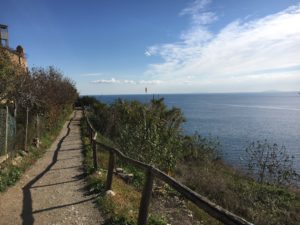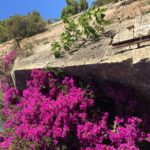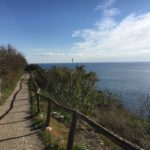- Created: 18 Novembre 2017 20:28
- Updated: 3 Aprile 2018 20:44
- Distance Instructions
- Distance 2 km
- Time 0 s
- Speed 6.0 km/h
- Min altitude 0 m
- Peak 0 m
- Climb 107 m
- Descent 99 m


Il sentiero n. 222, conosciuto come “Passeggiata Carmignani”, in memoria dell'ex generale Luciano Carmignani eletto sindaco di Porto Azzurro nel 1999 e prematuramente scomparso nel 2001, permette di collegare il centro del Paese con la Spiaggia di Barbarossa in circa 25 minuti.
Si tratta di un breve e facile itinerario, attrezzato con panchine, illuminazione e una rosa dei venti con le indicazioni dei luoghi che si possono osservare; il panorama è magnifico, dal turchese del mare sottocosta al Promontorio del Monte Calamita, fino all'Isola del Giglio. Si possono inoltre ammirare le due fortificazioni che sorvegliano l'ingresso del Golfo: il Forte Focardo si scorge volgendo lo sguardo a sud; il Forte San Giacomo, i cui possenti bastioni meridionali ed orientali sovrastano il sentiero, è utilizzato fin dal 1890 come carcere. Questa fortificazione fu edificata per volontà del Re Filippo III di Spagna nel 1604, all'epoca in cui il territorio di Porto Azzurro ricadeva sotto il dominio spagnolo. La via attraversa terrazzamenti e vecchie coltivazioni oggi per lo più abbandonate. La vegetazione è caratterizzata dalla presenza di alcune specie alloctone, piante non originarie del bacino del Mediterraneo, che si sono addattate a condizioni ambientali difficili. In particolare si possono osservare fichi, fichi d'india, oleandri, pini, eucalipti e agavi, particolari piante di origine messicana dalle spesse foglie carnose che vivono 12-15 anni e prima di morire producono una lunga e robusta infiorescenza che può raggiungere gli 8 mt di altezza.
Some people say that the origin of the name Barbarossa beach comes from the Turkish pirate Khayr al-Din Barbarossa who sacked the island in the sixteenth century destroying entire towns and taking numerous prisoners. From this beach you can reach the village of Porto Azzurro in 25 minutes along path n. 222, known as "Passeggiata Carmignani". This path was made in memory of the former General Luciano Carmignani who was elected mayor of Porto Azzurro in 1999 and prematurely died in 2001. It is a short, easy itinerary, with benches along the way, some lighting and a rose compass observation point. The view is magnificent here, from the turquoise sea below the promontory of Monte Calamita, right up to Giglio Island.
Also visible are the two fortifications that guard the entrance to the Gulf: Fort Focardo which can be seen looking south; and Forte San Giacomo, whose mighty southern and eastern bastions loom over the footpath. It has been in use as a prison since 1890. This fortress was built by order of King Philip III of Spain in 1604, at the time when the territory of Porto Azzurro fell under Spanish rule. The footpath below the fortress crosses terracing and old fields which are mostly abandoned these days.
The abundant vegetation is made up of plants and shrubs that are not typically Mediterranean but which have adapted to difficult environmental conditions. In particular you can see figs, prickly pears, oleanders, pines, eucalyptus and agaves, plants of Mexican origin with thick fleshy leaves that live up to 12-15 years and before dying produce a long and robust inflorescence that can grow up to 8 mt.
Ursprünglich kommt der Name des Strandes Barbarossa vom türkischen Pirat Khayr al-Din Barbarossa der im XVI Jahrhundert die Insel räuberte, zerstörte ganze Dörfer und nahm viele Gefangen.
In 25 Minuten erreichen Sie das Dorf von Porto Azzurro auf dem Weg Nr. 222, genannt “Passeggiata Carmignani”, ein Ex-General der dann Bürgermeister von Porto Azzurro 1999 geworden ist und 2001 verstarb. Es ist eine einfache und kurze Strecke, mit Sitzbank, Straßenbeleuchtung und Windrose ausgerüstet. Das Panorama ist wunderschön: das Türkise Meer der Küste das von Monte Calamita bis zur Insel von Giglio geht. Weiterhin sind zwei Befestigungen zu sehen: Forte Focardo wenn man Richtung Süden schaut und Forte San Giacomo oberhalb den Weg (seit 1890 ein Gefängnis). Diese Festung wurde im Jahre 1604 vom König Filippo III aus Spanien zur Zeit der Spanische Beherrschung gebaut. Der Weg folgt weiter durch verlassene Gärten und Terrassenfelder. Die Vegetation besteht aus Pflanzen nicht vom Mittelmeer: Feigen, Indische Feigen, Oleander, Pinien und Agaven. Die Agaven sind besondere Pflanzen aus Mexico, mit fleischigen Blättern, können 12-15 Jahren leben und am Ende des Lebens eine Blume bis 8 Meter produzieren.


Il sentiero n. 222, conosciuto come “Passeggiata Carmignani”, in memoria dell’ex generale Luciano Carmignani eletto sindaco di Porto Azzurro nel 1999 e prematuramente scomparso nel 2001, permette di collegare il centro del Paese con la Spiaggia di Barbarossa in circa 25 minuti.
Si tratta di un breve e facile itinerario, attrezzato con panchine, illuminazione e una rosa dei venti con le indicazioni dei luoghi che si possono osservare; il panorama è magnifico, dal turchese del mare sottocosta al Promontorio del Monte Calamita, fino all’Isola del Giglio. Si possono inoltre ammirare le due fortificazioni che sorvegliano l’ingresso del Golfo: il Forte Focardo si scorge volgendo lo sguardo a sud; il Forte San Giacomo, i cui possenti bastioni meridionali ed orientali sovrastano il sentiero, è utilizzato fin dal 1890 come carcere. Questa fortificazione fu edificata per volontà del Re Filippo III di Spagna nel 1604, all’epoca in cui il territorio di Porto Azzurro ricadeva sotto il dominio spagnolo. La via attraversa terrazzamenti e vecchie coltivazioni oggi per lo più abbandonate. La vegetazione è caratterizzata dalla presenza di alcune specie alloctone, piante non originarie del bacino del Mediterraneo, che si sono addattate a condizioni ambientali difficili. In particolare si possono osservare fichi, fichi d’india, oleandri, pini, eucalipti e agavi, particolari piante di origine messicana dalle spesse foglie carnose che vivono 12-15 anni e prima di morire producono una lunga e robusta infiorescenza che può raggiungere gli 8 mt di altezza.
Some people say that the origin of the name Barbarossa beach comes from the Turkish pirate Khayr al-Din Barbarossa who sacked the island in the sixteenth century destroying entire towns and taking numerous prisoners. From this beach you can reach the village of Porto Azzurro in 25 minutes along path n. 222, known as “Passeggiata Carmignani”. This path was made in memory of the former General Luciano Carmignani who was elected mayor of Porto Azzurro in 1999 and prematurely died in 2001. It is a short, easy itinerary, with benches along the way, some lighting and a rose compass observation point. The view is magnificent here, from the turquoise sea below the promontory of Monte Calamita, right up to Giglio Island.
Also visible are the two fortifications that guard the entrance to the Gulf: Fort Focardo which can be seen looking south; and Forte San Giacomo, whose mighty southern and eastern bastions loom over the footpath. It has been in use as a prison since 1890. This fortress was built by order of King Philip III of Spain in 1604, at the time when the territory of Porto Azzurro fell under Spanish rule. The footpath below the fortress crosses terracing and old fields which are mostly abandoned these days.
The abundant vegetation is made up of plants and shrubs that are not typically Mediterranean but which have adapted to difficult environmental conditions. In particular you can see figs, prickly pears, oleanders, pines, eucalyptus and agaves, plants of Mexican origin with thick fleshy leaves that live up to 12-15 years and before dying produce a long and robust inflorescence that can grow up to 8 mt.
Ursprünglich kommt der Name des Strandes Barbarossa vom türkischen Pirat Khayr al-Din Barbarossa der im XVI Jahrhundert die Insel räuberte, zerstörte ganze Dörfer und nahm viele Gefangen.
In 25 Minuten erreichen Sie das Dorf von Porto Azzurro auf dem Weg Nr. 222, genannt “Passeggiata Carmignani”, ein Ex-General der dann Bürgermeister von Porto Azzurro 1999 geworden ist und 2001 verstarb. Es ist eine einfache und kurze Strecke, mit Sitzbank, Straßenbeleuchtung und Windrose ausgerüstet. Das Panorama ist wunderschön: das Türkise Meer der Küste das von Monte Calamita bis zur Insel von Giglio geht. Weiterhin sind zwei Befestigungen zu sehen: Forte Focardo wenn man Richtung Süden schaut und Forte San Giacomo oberhalb den Weg (seit 1890 ein Gefängnis). Diese Festung wurde im Jahre 1604 vom König Filippo III aus Spanien zur Zeit der Spanische Beherrschung gebaut. Der Weg folgt weiter durch verlassene Gärten und Terrassenfelder. Die Vegetation besteht aus Pflanzen nicht vom Mittelmeer: Feigen, Indische Feigen, Oleander, Pinien und Agaven. Die Agaven sind besondere Pflanzen aus Mexico, mit fleischigen Blättern, können 12-15 Jahren leben und am Ende des Lebens eine Blume bis 8 Meter produzieren.


